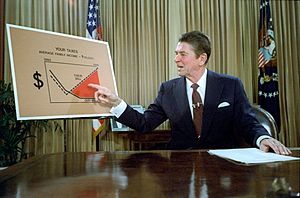Reaganomics facts for kids

Reaganomics is a special word that combines "Reagan" and "economics." It describes the economic plans put in place by Ronald Reagan when he was the President of the United States in the 1980s. Many of these ideas are still used today.
These policies are often linked to something called supply-side economics. Supporters called it "free market economics." Some people who didn't agree with it called it "trickle-down economics."
The main goals of Reaganomics were to:
- Slow down how much the government spent.
- Lower federal income tax and taxes on investments.
- Reduce government rules.
- Control the money supply to lower inflation.
Contents
Understanding Reaganomics
Reaganomics was a big change in how the U.S. government handled the economy. President Reagan believed that if people and businesses had more money, they would spend and invest more. This would help the economy grow.
Lowering Taxes
One of the biggest parts of Reaganomics was cutting taxes. Reagan believed that high taxes stopped people from working hard and businesses from growing. He wanted to lower taxes for everyone, especially for businesses and wealthy people.
- The idea was that if businesses paid less tax, they would have more money.
- They could then use this money to hire more people or build new factories.
- This would create more jobs and make the economy stronger.
- People would also have more money to spend, which would help businesses.
Reducing Government Spending
Another key goal was to slow down the growth of government spending. Reagan believed the government was spending too much money. He wanted to cut back on some programs.
- He aimed to reduce the size and cost of the federal government.
- This was meant to make the government more efficient.
- It was also hoped that less government spending would help control prices.
Fewer Government Rules
Reagan also wanted to reduce government rules. These rules often told businesses how they had to operate. He felt that too many rules made it hard for businesses to grow and create jobs.
- By removing some rules, businesses could operate more freely.
- This was supposed to make it easier for companies to innovate and expand.
- It was believed this would lead to more competition and lower prices for consumers.
Controlling Inflation
In the years before Reagan became president, the U.S. had a big problem with inflation. This means that prices for goods and services were rising very quickly. Reagan wanted to stop this.
- His plan involved tightening the money supply.
- This meant making it harder for banks to lend money.
- The goal was to slow down the economy just enough to stop prices from rising so fast.
- Controlling inflation was seen as very important for the economy's health.
Impact of Reaganomics
Reaganomics had a big impact on the U.S. economy during the 1980s and beyond. There are different views on how successful it was.
Economic Growth
During Reagan's time in office, the U.S. economy saw a period of strong growth.
- After a recession early in his presidency, the economy began to expand.
- Many new jobs were created.
- The country saw a rise in its gross domestic product (GDP), which measures how much the country produces.
Inflation and Unemployment
One of the clear successes was bringing down inflation.
- The strict policies helped to control rising prices.
- However, the early years of Reagan's presidency also saw high unemployment.
- Over time, the unemployment rate did fall significantly.
National Debt
While the economy grew, the national debt also increased a lot during the 1980s.
- Even with spending cuts, the government spent more than it took in from taxes.
- This led to larger budget deficits.
- The national debt grew from about $900 billion to nearly $2.6 trillion.
Income Inequality
Some people argue that Reaganomics led to a wider gap between rich and poor.
- Tax cuts favored wealthier people and businesses.
- Critics say this made the rich richer, while others did not benefit as much.
- Supporters argue that everyone benefited from a stronger economy.
Legacy of Reaganomics
The ideas of Reaganomics have continued to influence U.S. economic policy for many years. Many politicians still debate whether these policies were good or bad for the country in the long run.
- The focus on lower taxes and fewer government rules remains a key part of one political party's platform.
- The debate over government spending and the national debt also continues.
- Reaganomics changed how many people think about the role of government in the economy.
Images for kids
-
President Ronald Reagan signs the Economic Recovery Tax Act of 1981 at his California ranch.
See also
 In Spanish: Reaganomía para niños
In Spanish: Reaganomía para niños








